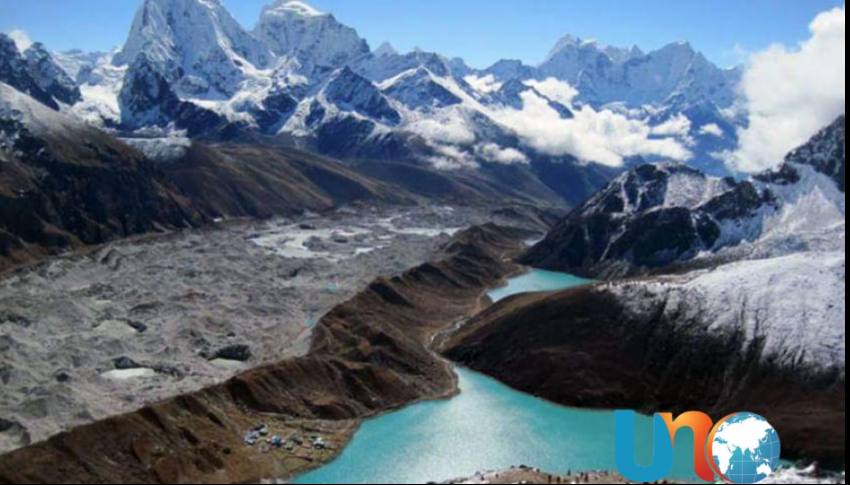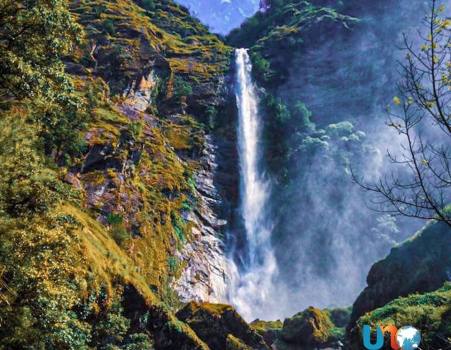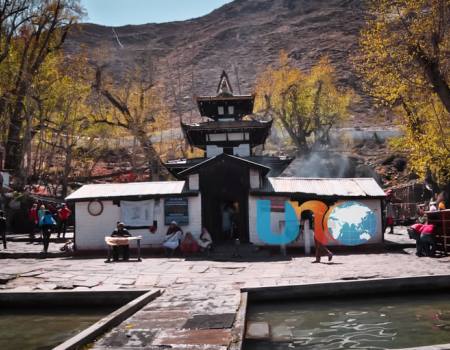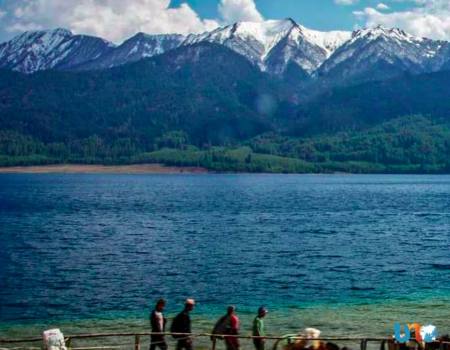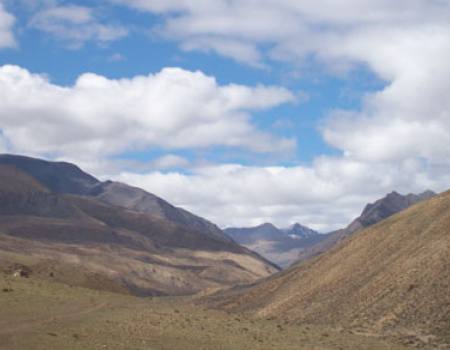Retrace trail to Gokyo-Ri, Chola Pass, Kalapatthar, Everest Base Camp Trek
The Gokyo-Ri, Chola Pass, Kalapatthar, and Everest Base Camp Trek is an epic journey that takes you through the stunning landscapes of the Everest region in Nepal. This trek offers a unique combination of high-altitude lakes, panoramic mountain views, challenging passes, and the opportunity to stand at the foot of the world's highest peak.
The adventure begins with a scenic flight from Kathmandu to Lukla, a small mountain airstrip nestled amidst the Himalayas. From Lukla, you embark on a trek that gradually ascends along the Dudh Koshi River, passing through lush forests, picturesque Sherpa villages, and suspension bridges adorned with colorful prayer flags.
The first major highlight of the trek is reaching Namche Bazaar, a vibrant Sherpa town and the gateway to the Everest region. Here, you take a rest day to acclimatize and explore the surroundings. The panoramic views of mountains like Ama Dablam and Thamserku from Namche Bazaar are awe-inspiring.
Continuing on the trail, you venture into less-frequented areas, trekking through remote villages and alpine landscapes. As you ascend higher, the air becomes thinner, and the terrain gets more rugged. The trek to Gokyo presents breathtaking views of snow-capped peaks, including Cho Oyu, the world's sixth highest mountain.
Gokyo itself is a hidden gem, with a series of turquoise lakes shimmering against the backdrop of towering mountains. A hike up to Gokyo-Ri, a vantage point above Gokyo, rewards you with an incredible panorama of the Himalayas. The sight of Everest, Lhotse, Makalu, and Cho Oyu dominating the skyline is nothing short of awe-inspiring.
Leaving Gokyo behind, you cross the challenging Chola Pass, which demands careful navigation and may be covered in snow depending on the season. The pass rewards you with spectacular views as you descend into the secluded valley of Dzongla. From here, you continue towards Lobuche, passing through glacial moraines and memorials dedicated to mountaineers who lost their lives on Everest.
The final stretch of the trek takes you to Gorak Shep, the last settlement before Everest Base Camp. The hike to Everest Base Camp itself is a thrilling experience, where you walk in the footsteps of legendary mountaineers. Standing at the base of Mount Everest, surrounded by towering peaks, is an indescribable feeling of accomplishment.
For even better views of Everest, you ascend Kalapatthar, a viewpoint known for its breathtaking sunrise vistas. The sight of the sun illuminating the Everest massif is a sight to behold and a perfect way to culminate your trek.
After descending from Kalapatthar, you retrace your steps back to Lukla, passing through Namche Bazaar and enjoying the familiar landscapes in reverse. Finally, you take a domestic flight from Lukla back to Kathmandu, where you can reflect on your incredible journey and soak in the memories of the breathtaking Himalayan landscapes.
The Gokyo-Ri, Chola Pass, Kalapatthar, and Everest Base Camp Trek is a challenging adventure that requires physical fitness, proper acclimatization, and preparation. It's important to trek with a reputable guide or agency, carry the necessary equipment, and adhere to safety guidelines. With determination and the right mindset, this trek offers a once-in-a-lifetime opportunity to experience the majesty of the Everest region and create unforgettable memories.
Trip Highlights
Trekking Type: Camping Trek/tea House Trek.
Trekking Grade: Strenuous and Moderate
Maximum Altitude: 5,550 m Kalapathaar.
Best Season: October - November & March-May
Duration: 18 Days
Outline Itinerary
- Day 01:Arrive Kathmandu in International Airport
- Day 02:Kathmandu sightseeing and preparation.
- Day 03:Flight from Kathmandu to Lukla (2850m)
- Day 04:Trek to Phakding (2,652m/8,700ft)
- Day 05:Trek to Namche Bazaar (3,440m/11,286ft)
- Day 06:Acclimatization day in Namche Bazaar
- Day 07:Trek to Dole (4,200m/13,780ft)
- Day 08:Trek to Machhermo (4,470m/14,665ft)
- Day 09:Trek to Gokyo (4,790m/15,715ft)
- Day 10:Hike to Gokyo-Ri (5,357m/17,575ft)
- Day 11:Trek to Thagnak (4,750m/15,584ft) via Dragnag
- Day 12:Cross Chola Pass (5,420m/17,782ft) and trek to Dzongla (4,830m/15,850ft)
- Day 13:Trek to Lobuche (4,910m/16,109ft)
- Day 14:Trek to Gorak Shep (5,160m/16,929ft) and hike to Everest Base Camp (5,364m/17,598ft)
- Day 15:Hike to Kalapatthar (5,545m/18,192ft) and trek to Pheriche (4,280m/14,042ft)
- Day 16:Trek to Namche Bazaar
- Day 17:Trek to Lukla
- Day 18:Flight back to Kathmandu
Detail Itinerary
- Day 1Arrive Kathmandu in International AirportArrive in Kathmandu at International Airport meet and greet with a flower garland and transfer to Hotel, Kathmandu, and evening trip briefing with the welcome dinner.
- Day 2Kathmandu sightseeing and preparation.Use this day to explore the culturally rich city of Kathmandu. Visit UNESCO World Heritage sites such as Pashupatinath Temple, Boudhanath Stupa, and Swayambhunath Stupa. In the afternoon, you will have a gear check and final preparation for the expedition
- Day 3Flight from Kathmandu to Lukla (2850m)Breakfast at 6 o'clock and after your breakfast transfer to the domestic airport, and fly to Lukla (2850m) for about 30 minutes with enjoying the whole mountain views on the north side of Annapurna to Everest. So that is better to choose the left-side seat on the plane. And meet your porters who will be waiting and about 30 minutes break in the Lodge have a cup of tea, or coffee trek starts with your guide to Phakding (2640m) Overnight This day Descend to Chaurikharka valley from Lukla and straight/flat continue through the Chomlo, Tharokoshi, Ghat zigzag up and down with right side Kushumkhang and opposite Kongde Ridge and Left side Dudh Koshi valley river view. It is the first day very nice Journey and on the way lunch break in Ghat and get to Phakding.
- Day 4Trek to Phakding (2,652m/8,700ft)After landing in Lukla, you'll start your trek by descending to Phakding. The trail follows the Dudh Koshi River and passes through picturesque Sherpa villages and lush forests.
- Day 5Trek to Namche Bazaar (3,440m/11,286ft)The next day, you'll continue along the river, crossing suspension bridges and ascending steep trails. Eventually, you'll reach Namche Bazaar, the bustling Sherpa town and the primary trading center of the region.
- Day 6Acclimatization day in Namche BazaarIt's crucial to acclimatize properly to avoid altitude sickness. You'll spend a day in Namche Bazaar, allowing your body to adjust to the increasing altitude. You can explore the town, visit the Sherpa Museum, and enjoy the panoramic views of the surrounding mountains.
- Day 7Trek to Dole (4,200m/13,780ft)From Namche Bazaar, the trail leads you through rhododendron forests and crosses several small settlements. You'll pass by Mong La, enjoy scenic views, and finally reach Dole, a small village with stunning mountain vistas.
- Day 8Trek to Machhermo (4,470m/14,665ft)The trail continues uphill from Dole, passing through alpine landscapes and yak pastures. You'll arrive at Machhermo, a picturesque village located in a wide valley beneath the Kyajo Ri mountain.
- Day 9Trek to Gokyo (4,790m/15,715ft)Leaving Machhermo, you'll head towards Gokyo, which is renowned for its turquoise lakes. The trek offers incredible views of Cho Oyu, the world's sixth highest mountain. You'll reach Gokyo in the afternoon and can explore the stunning Gokyo Lakes.
- Day 10Hike to Gokyo-Ri (5,357m/17,575ft)Gokyo-Ri is a viewpoint that provides breathtaking panoramic views of the Himalayas, including Everest, Lhotse, Makalu, and Cho Oyu. You'll start early in the morning to witness the sunrise and capture the mesmerizing scenery. After enjoying the views, you'll descend back to Gokyo.
- Day 11Trek to Thagnak (4,750m/15,584ft) via DragnagLeaving Gokyo behind, you'll make your way to Thagnak. The trail takes you across the Ngozumpa Glacier, the largest glacier in the Himalayas. You'll traverse rocky terrain and reach Thagnak, a small village located in a glacial valley.
- Day 12Cross Chola Pass (5,420m/17,782ft) and trek to Dzongla (4,830m/15,850ft)This is a challenging day as you ascend steeply towards Chola Pass. The pass offers stunning views but requires careful navigation. After crossing the pass, you'll descend towards Dzongla, where you'll spend the night.
- Day 13Trek to Lobuche (4,910m/16,109ft)From Dzongla, the trail follows a relatively easier path as you make your way to Lobuche. Along the way, you'll pass the Dughla Pass and encounter memorials dedicated to climbers who lost their lives on Everest.
- Day 14Trek to Gorak Shep (5,160m/16,929ft) and hike to Everest Base Camp (5,364m/17,598ft)The trail continues towards Gorak Shep, the last settlement before Everest Base Camp. After reaching Gorak Shep, you'll have a quick lunch and embark on a challenging hike to Everest Base Camp. It's an awe-inspiring experience to stand at the foot of the world's
- Day 15Hike to Kalapatthar (5,545m/18,192ft) and trek to Pheriche (4,280m/14,042ft)Early in the morning, you'll climb to Kalapatthar, a famous vantage point that offers unparalleled views of Mount Everest at sunrise. After capturing the stunning vistas, you'll descend to Pheriche, a village known for its Himalayan Rescue Association clinic.
- Day 16Trek to Namche BazaarFrom Pheriche, you'll retrace your steps back to Namche Bazaar. It's a long but rewarding trek as you revisit familiar trails and enjoy the beautiful surroundings.
- Day 17Trek to LuklaOn the last leg of the trek, you'll trek from Namche Bazaar to Lukla, where you'll spend your final night in the Everest region. It's a good opportunity to reflect on your journey and celebrate your accomplishments with fellow trekkers.
- Day 18Flight back to KathmanduThe next morning, you'll board a domestic flight from Lukla to Kathmandu. Upon arrival, you can relax, explore the city, and reminisce about your incredible adventure in the Everest region.
What's Includes:
- Airport / Hotel / Airport pick up & drop by private Vehicle.
- Four-night standard accommodation in star level hotel in Kathmandu.
- Meals on full board (Breakfast, lunch, and dinner) during trekking.
- All accommodations during the trek.
- Langtang Valley Trekking map.
- Both ways Drive Local Bus fare.
- An experienced Government licensed holder guide and porter to carry your luggage during the trek.
- Food, drinks, accommodation, insurance, salary, equipment, transportation, and local taxes.
- Group medical supplies (first aid kits)
- All necessary paper works and national park entry permits.
- Travel & Rescue arrangement.
- All government taxes.
- If you are interested we can provide a video of that route.
What's Excludes:
- Meals whilst in Kathmandu allow US$ 10 - US$ 12 per day.
- Your travel insurance.
- International airfare.
- Nepal entry visa (You can obtain a visa easily upon your arrival at Nepal’s Airport in Kathmandu).
- All kinds of drinks (Alcoholic, hot and cold drinks)
- Personal shopping and laundry etc.
- Personal trekking Equipment.
- UNO Travels and Adventure sleeping bag, down jackets, Duffle bag, and walking stick, if necessary.
- Tips for trekking staff and drivers.
Trip Note
Trip Note: Gokyo-Ri, Chola Pass, Kalapatthar, Everest Base Camp Trek
Duration: Approximately 18-20 days (including arrival and departure days)
Best Time to Trek: The best seasons for this trek are spring (March to May) and autumn (September to November). These months offer stable weather, clear skies, and favorable trekking conditions. However, it's essential to check the weather forecast and be prepared for variable weather conditions at high altitudes.
Physical Fitness and Preparation: The Gokyo-Ri, Chola Pass, Kalapatthar, and Everest Base Camp Trek is a strenuous trek that involves long days of walking and substantial altitude gains. Prior physical fitness and cardiovascular endurance are crucial. It's recommended to engage in regular aerobic exercises and hiking to prepare for the trek. Consult with a healthcare professional before undertaking any intense physical activities.
Permits and Documentation:
1. Sagarmatha National Park Entry Permit: This permit is required to enter the Sagarmatha National Park, where Everest Base Camp is located.
2. TIMS (Trekkers' Information Management System) Card: This card is necessary for trekking in the Everest region and helps in recording trekker information and maintaining trekking records.
3. It's advisable to carry a few passport-sized photographs and a copy of your passport for permit applications.
Accommodation: During the trek, you'll be staying in tea houses or lodges along the trail. These basic accommodations provide rooms with twin beds, shared bathrooms, and communal dining areas. It's essential to be prepared for simple facilities, limited electricity, and cold showers at higher altitudes. It's recommended to bring a sleeping bag suitable for cold temperatures.
Meals: Meals during the trek are typically provided at the tea houses and lodges. The menus offer a variety of dishes, including Nepali, Tibetan, and Western cuisine. Dal Bhat (lentil soup with rice), momo (dumplings), pasta, noodles, and various soups are commonly available. It's advisable to stick to a balanced diet and drink plenty of fluids to stay hydrated.
Altitude and Acclimatization: The trek involves gaining significant altitude, and it's essential to acclimatize properly to avoid altitude sickness. Acclimatization days are included in the itinerary at strategic points like Namche Bazaar and Dingboche. It's crucial to follow the advice of your guide, maintain a gradual ascent, drink plenty of water, and be aware of any symptoms of altitude sickness.
Guides and Porters: Hiring a professional guide and porter is highly recommended for this trek. A guide provides valuable local knowledge, navigational assistance, and ensures your safety throughout the trek. A porter can help carry your heavy backpack, allowing you to trek with ease. It's advisable to book through a reputable trekking agency that provides trained and experienced guides and porters.
Health and Safety:
1. Travel insurance that covers high-altitude trekking, helicopter evacuation, and medical emergencies is essential. Ensure your insurance policy is valid for the duration of your trek.
2. Stay hydrated by drinking plenty of water and avoid consuming untreated water. It's advisable to use water purification tablets or carry a water filter.
3. Carry a basic first aid kit, including medications for common ailments like headaches, upset stomachs, and altitude sickness. Consult with a travel doctor for personalized medical advice before the trek.
4. Respect the local culture, customs, and traditions. Dress modestly, be mindful of local etiquette, and ask for permission before taking photographs of local people.
Equipment and Gear:
1. Good quality, waterproof trekking boots with ankle support.
2. Layered clothing to adapt to changing weather conditions, including thermal base layers, fleece jackets,
Quick Inquiry
Trip Facts
- Transportation:
- Meals:Breakfast + Lunch + Dinner
- Accommodation:Lodge to lodge
- Altitude:5,550m
